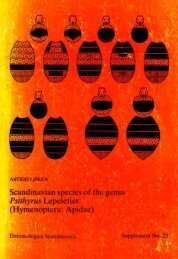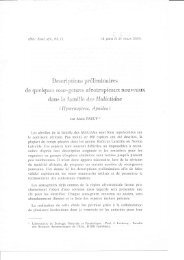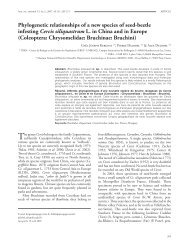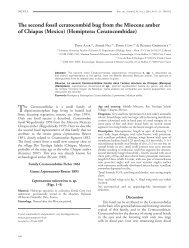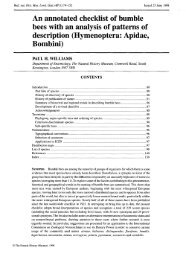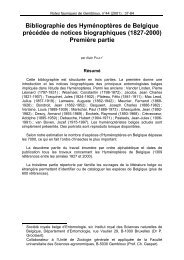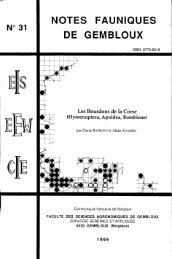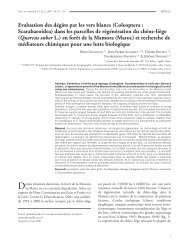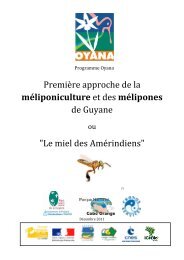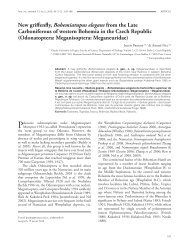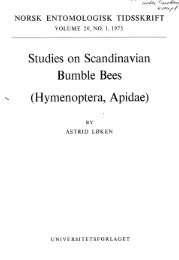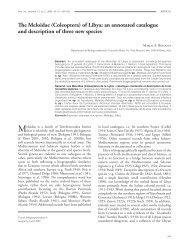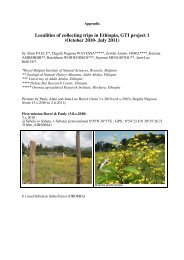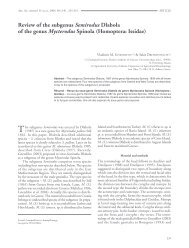ASEF 4-2009.indb - Laboratoire de Zoologie
ASEF 4-2009.indb - Laboratoire de Zoologie
ASEF 4-2009.indb - Laboratoire de Zoologie
Create successful ePaper yourself
Turn your PDF publications into a flip-book with our unique Google optimized e-Paper software.
Type collections are invaluable repositories of<br />
biological information and comprise unique and<br />
irreplaceable taxonomic and natural history reference<br />
material (Suarez & Tsutsui 2004; Wheeler et al. 2004).<br />
Type specimens, the “bearers of the scientifi c names of<br />
all nominal species-group taxa” (art. 72.10 of the ICZN<br />
1999) are obvious objects of interest for systematics<br />
and taxonomists and studies in many other branches<br />
of scientifi c en<strong>de</strong>avor (Alberch 1993; Winston 2007).<br />
It is crucially important to catalogue and digitise this<br />
information, noting the site of <strong>de</strong>position of type<br />
specimens and their state of conservation for wi<strong>de</strong><br />
dissemination (Garrett 1989; Michalski 1992).<br />
Th e use of label data from natural history<br />
collections has improved our un<strong>de</strong>rstanding of<br />
ecology, biogeography and evolutionary biology and<br />
conservation biology (Freitag et al. 1998; Soberón<br />
et al. 2000; Soberón et al. 2003; Reddy & Davalos<br />
2003; Meier & Dikow 2004, O’Connel et al. 2004).<br />
Museum specimens are evi<strong>de</strong>nce of the geographic<br />
location of a species at a given time. Th is information<br />
can be integrated in mo<strong>de</strong>ls exploring the geographic<br />
components of ecological processes, biodiversity and<br />
global change (Graham et al. 2004; Rahbek et al.<br />
2007; but see Rowe 2005). Results from these studies<br />
attest to the benefi ts of mo<strong>de</strong>rn database techniques,<br />
especially in terms of the dissemination of information<br />
from sources (museums) to users (scientists and policy<br />
makers) (Meier & Dikow 2004).<br />
Our fi rst objective was to review the type collection<br />
of the Invertebrate Section of the Museum of Zoology<br />
QCAZ (Quito, CAtólica, Zoología) at the Pontifi cia<br />
Universidad Católica <strong>de</strong>l Ecuador (PUCE) in Quito.<br />
Th e museum was established in 1981 un<strong>de</strong>r the<br />
direction of Dr. Giovanni Onore as a unit of the School<br />
of Biological Sciences at PUCE. Additional information<br />
concerning the Museum’s history, structure, functions<br />
and challenges may be found in Barragán et al. (this<br />
issue) and Dangles et al. (this issue). From its start<br />
in the early 1980’s, PUCE scientists and stu<strong>de</strong>nts<br />
have collected invertebrates in mainland Ecuador, in<br />
the Galápagos Islands and associated shallow water<br />
marine habitats, a practice that continues today. Th ese<br />
specimens comprise the bulk of the museum’s holdings<br />
and are stored in cabinets until they can be curated and<br />
i<strong>de</strong>ntifi ed by specialised taxonomists. Th ese collections<br />
have motivated scientifi c research insi<strong>de</strong> and outsi<strong>de</strong><br />
Ecuador and have resulted in the <strong>de</strong>scription of several<br />
hundred new species to science. Vouchers of these new<br />
species are stored in the Museum as type specimens. For<br />
example, the collection holds the fi rst records of several<br />
agricultural pests including several species of fruit fl ies<br />
Anastrepha spp. (Diptera: Tephritidae; Calles & Ponce<br />
438<br />
D. A. Donoso, F. Salazar, F. Maza, R. E. Cár<strong>de</strong>nas & O. Dangles<br />
2003), Eucalyptus pests, Phoracantha semipunctata<br />
(Coleoptera: Cerambycidae) and the potato moth,<br />
Tecia solanivora (Lepidoptera: Gelechiidae; Barragán<br />
et al. 2004, Pollet et al. 2003). Collections of the<br />
insect vectors of human and veterinary disease such<br />
as the vectors of Chagas and other diseases caused by<br />
trypanosomes (Aguilar et al. 1999; Cár<strong>de</strong>nas & Vieira<br />
2005; Palomeque et al. 2003; Pinto et al. 2003; Pinto<br />
et al. 2006;) are also housed in the Museum.<br />
Our second objective was to examine spatial patterns<br />
in the collection and potential bias of the type material<br />
in documenting Ecuadorian invertebrate diversity,<br />
using geographical information systems (GIS) coupled<br />
to spatial analysis. Our goal is to provi<strong>de</strong> to Ecuadorian<br />
authorities and policy makers basic information on<br />
the conservation status of the invertebrate fauna in<br />
Ecuador. Th is information can serve as a gui<strong>de</strong> for<br />
conservation and biodiversity eff orts (Shi et al. 2005).<br />
Review of type specimens<br />
Materials and Methods<br />
From 2005–2008, an intensive search of the wet and dry<br />
collections of the Museum for specimens labeled or i<strong>de</strong>ntifi ed<br />
as “type” specimens (i.e. holotypes, paratypes, allotypes,<br />
neotypes, topotypes; but also specimens with a colored label)<br />
was done. Th ese specimens were separated from the collection<br />
and their i<strong>de</strong>ntity as type specimens was confi rmed using<br />
original literature. When required, specimens were curated<br />
(i.e. change of alcohol, container, oxidized pins, addition of a<br />
restored label), but no original label, or other information, was<br />
removed from any specimen. Type specimens are maintained<br />
separately from the main collection and kept in <strong>de</strong>signated<br />
locked cabinets un<strong>de</strong>r specifi c light and humidity conditions<br />
for long-term storage (Garrett 1989; Michalski 1992).<br />
Type specimens were the initial focus of a current initiative of the<br />
Museum to digitise specimen label information for all museum<br />
specimens. Museum personnel established a strict digitisation<br />
protocol, which consists of the following steps. Label data from<br />
specimens stored in the museum cabinets (i.e. mainly country<br />
of origin, province, locality, altitu<strong>de</strong>, geographic coordinates,<br />
date, collector, <strong>de</strong>termination, and other ecological data) were<br />
recor<strong>de</strong>d in a specially <strong>de</strong>signed database (Apple Macintosh<br />
Filemaker Pro). Th e lowest taxonomic rank for each specimen<br />
was checked and recor<strong>de</strong>d in the database up to Phylum<br />
(Triplehorn & Johnson 2005). Th is digitised information<br />
was linked to a unique accession number label (e.g. Tipos<br />
QCAZI 00001, for type specimens; QCAZI 00001, for other<br />
specimens), which was ad<strong>de</strong>d to every specimen.<br />
Georeferencing<br />
We used label data as the main source of information to<br />
georeference type specimens <strong>de</strong>posited in the Museum. Due to<br />
the age of these collections (mostly from 1980’s and 1990’s), a<br />
consi<strong>de</strong>rable number of data labels (72%) had no geographic<br />
coordinates. Before the wi<strong>de</strong>spread use of geographic<br />
information systems (GIS) products such as global positioning<br />
systems (GPS) and electronic gazetteers in the mid 1990’s, most



